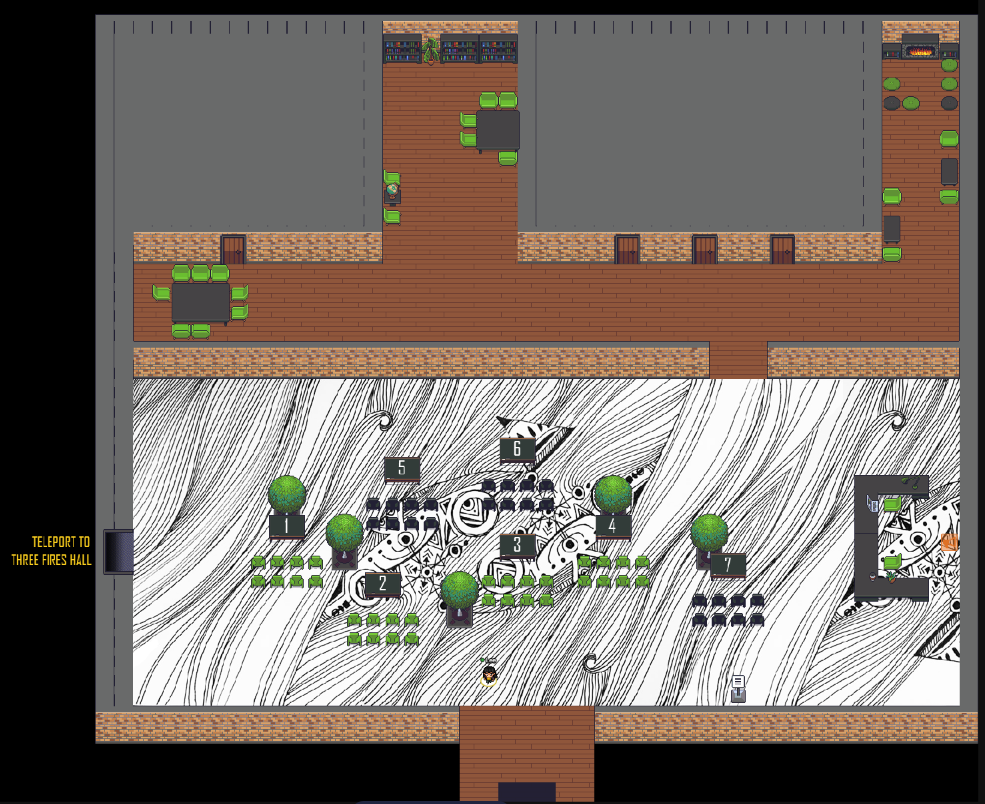Art, Essay and Creative Writing Showcase
- [1] Advocacy Posters
- [2] Against The Flow: Resisting Surveillance Capitalism by Watercoloring Photos
- [3] DEAR DAUGHTERS
- [4] Linking Art and Science to Catalyze Creative Thinking and Scientific Inquiry
- [5] Lost in an Herbere': Mourning and Loss in the Medieval Pearl-poem.
- [6] Moon's Beloved Coyote (Aurora Borealis): A New Age Origin Story
- [7] Toxic Love
[1]
Advocacy Posters, 2020
Graphic Design
18inx24in
Jalen Sims, Senior - Graphic Design
Faculty Mentor: Jane Milkie - Art & Design
Art Showcase
The work I am submitting for the Celebration of Student is a pair of advocacy posters. These are black and white pieces that advocate for social justice and uniting as humans to fight injustices in our society. I thought of making these posters in the summer of 2020 during the height of people becoming aware of our unjust society. I want people to ask themselves "how am I helping unite Americans in the quest for solidarity and protecting our rights?" I also want people to ask themselves "In what ways am I spreading love to others?"
[2]
Against The Flow: Resisting Surveillance Capitalism by Watercoloring Photos, 2021
Mixed Media
4ftx4ft
Gabriel Hudson, Senior – Art & Design
Faculty Mentor: Tracy Wascom – Art & Design
Art Showcase
For my AD 485 Methodology project, I began watercolor painting the profile picture of all 1020 members of a Facebook group I created for my college. To make the goal manageable: each portrait is 3"x3"; with 10 minutes allotted for rendering. The finished collection will be an 8'x8' square (32x32 portraits), symbolizing a communal portrait. Besides practicality, I chose watercolor because its potentials for precision and unpredictability are essential to render my true subject: surveillance capitalism. My portraits of people are a shadow of surveillance capitalism's capacity to generate psychological portraits from data. I intend to counter surveillance capitalism's dehumanizing processes via artistic abstractions. I can't paint surveillance capitalism itself; I can paint the people affected by it. My intention is that the viewer will intuit the presence of the invisible system just as they intuit the forms of these portraits via their negative spaces. We share on social media expecting an audience, but we cannot control its reception; resulting in a twisted Roland Barthes, "Death of the User/Birth of the System." My project at first reveals the flow of data toward the benefit of these systems, but then it redirects that current. I do not want the audience to believe surveillance capitalism is "too big" to combat or that the only choice is to surrender to the tide of technology. My hope is that my art manifests surveillance capitalism in a form that is appropriately intimidating yet approachable. An 8'x8' portrait is intimidating. However, what I've rendered is not an inhuman visage: it is the face of my friends, my professors, and my people. "Against The Flow" is a means of combating the dehumanizing, predictive processes of surveillance capitalism by painstakingly recognizing and reinstating the individual as a source of autonomy and unpredictable expression.
[3]
DEAR DAUGHTERS, 2021
Graphite on Paper
9inx11in
Stephanie Dye, Sophomore - Secondary Education - English
Faculty Mentor: Leslie Larkin - English
Art Showcase
When working on my final project for my EN379 course this semester, I was inspired to create this creative visual art that reflects my feelings on motherhood and the relation between mothers and raising strong, critically thinking children. My work, which was inspired by Ta-Nehisi Coates' Between the World and Me and Anna Malaika Tubbs' The Three Mothers, reflects the desires parents have for and lessons they wish to pass on to their children. In both literary pieces that inspired this art, we examine and explore how the parents are passing their own lessons on to their children. Ta-Nehisi Coates explains lessons to his son that he has learned and how the three mothers of America's most well-known black rights activists, Malcolm X, Martin Luther King Junior and James Baldwin guided their sons to greatness. I was interested in how the parental, especially the mother's, influence affected the character of each man's progression through life. It is intriguing to factor in the different cultures, lifestyles, and characteristics of the parents to connect similarities within these iconic men's upbringings. While researching this project, I am examining the childhoods of Malcom X, Martin Luther King Junior and James Baldwin to explore the similarities and differences to that of Ta-Nehisi Coates and examine how each of their mother's teachings and rearing had an influence on why they developed into the men that they became. I was also to inspired to reflect on the same weaknesses, rules and restrictions forced upon women in a similar way that they were forced upon Black Americans. I recognized and worked to connect key elements in the midst of these repressions that allowed the influential mothers to create extremely intelligent and determined sons while being suppressed. Why these women were able to guide their children to greatness.
[4]
Linking Art and Science to Catalyze Creative Thinking and Scientific Inquiry, 2020-21
Digital Illustration
612x792 pixels
Claire Jorgensen, Freshman - Art & Design
Faculty Mentor: Dr. Diana Lafferty - Biology
Art Showcase
A bourgeoning body of literature indicates that visual arts can connect people to science by appealing to the affective domain of learning (i.e., attitude, emotion, engagement) rather than engaging the cognitive domain (i.e., application, comprehension, understanding) that is typically emphasized in science education. In fact, evidence suggests that art-based science communication catalyzes creativity and discovery thereby promoting intuitive thinking. Thus, my goal is synergize art and science through accurate scientific illustration to make wildlife microbial ecology more accessible to the general public and inspire people to consider the relationships between mammals and their microbes. To achieve my goal, I am collaborating with the Wildlife Ecology and Conservation Science Lab at NMU to create accurate, fine-scale natural history illustrations of mammals, the environments in which they live, and their gastrointestinal tracts in order to highlight the diverse micro-ecosystems that occur within the mammalian body. By synergizing art and science, I hope to inspire the general public to think more deeply about the interrelatedness of mammals and their microbes and to learn and grow their knowledge of the world around them.
[5]
'Lost in an Herbere': Mourning and Loss in the Medieval Pearl-poem
Dena VanEnkevort, Senior - English
Faculty Mentor: Dr. David Wood - English
Essay/Creative Writing
A medieval dream vision poem, Pearl follows the story of a Dreamer who is grieving the loss of a beautiful, perfect pearl: "In a garden green with grass, my cheer / Was lost! It lunged to land. O lot! / A lovelorn, longing look I bear / For that precious pearl without a spot"(9-12). Precisely what this pearl is or what it represents is never explicitly made clear, but its function as a representation of loss is its most important quality; in The Complete Works of the Pearl Poet, medievalist Casey Finch remarks that "the transcendental referent remains forever just beyond reach. Does the pearl finally typify the soul? God? Newborn innocence? Significantly, the question is left very much open"(32). In leaving the pearl's exact nature unnamed and undetermined, the poet expands the poem's audience, as people empathize with and relate to the Dreamer as he struggles with and comes to terms with his loss. To aid him in this endeavor, the dream vision God grants him allows the Dreamer to converse with a young heavenly maiden (who may represent the daughter he has lost). Despite the poet's indeterminacy in naming precisely what the pearl represents, placing it in the context of the conversation between the Dreamer and the maiden sets the poem's focus on the Dreamer's loss and the maiden's attempts at consolation. This depiction, and the Christian doctrine it facilitates, allows the poem to explore how people may seek a way to transcend various losses through faith in God.
[6]
Amber Essenmacher, Sophomore - English
Faculty Mentor: Dr. Patricia Killelea - English
Essay/Creative Writing
Moon's Beloved Fox (Foxfire) explores the relationship between animals and the stars/constellations and, more importantly, the northern lights (Aurora Borealis). It is inspired by mythical Finnish stories of the fire fox (revontulet). The poem's speaker, Fox, wishes for individuality, and The Moon grants him his desires. Through personification, readers are encouraged to accept nature as foundational to our world. Moon's Beloved Fox (Foxfire) appears in iambic pentameter with an alternating end-rhyme scheme. This piece aims to inspire students to think creatively and abstractly about the world around them.
[7]
AJ Carpenter, Junior - Psychology
Faculty Mentor: Jeremy Biesbrouck - Psychology
Essay/Creative Writing
As you read this piece, your mind will drift towards the writing being about a toxic relationship between two individuals. In reality, this piece is about the toxicity of being lactose intolerant but still having love for cheese. There are many subliminal messages portrayed throughout the poem that only the reader will understand by reading it a second time after the last line; "cheese". This writing is a reflection of my own personality by coping with serious situations through humor. Toxic Love calls for interpretation by the reader but if the hidden message is found, it shows how everything is not always as serious as your mind pushes to make you believe. It's okay to find the light in dark situations.

